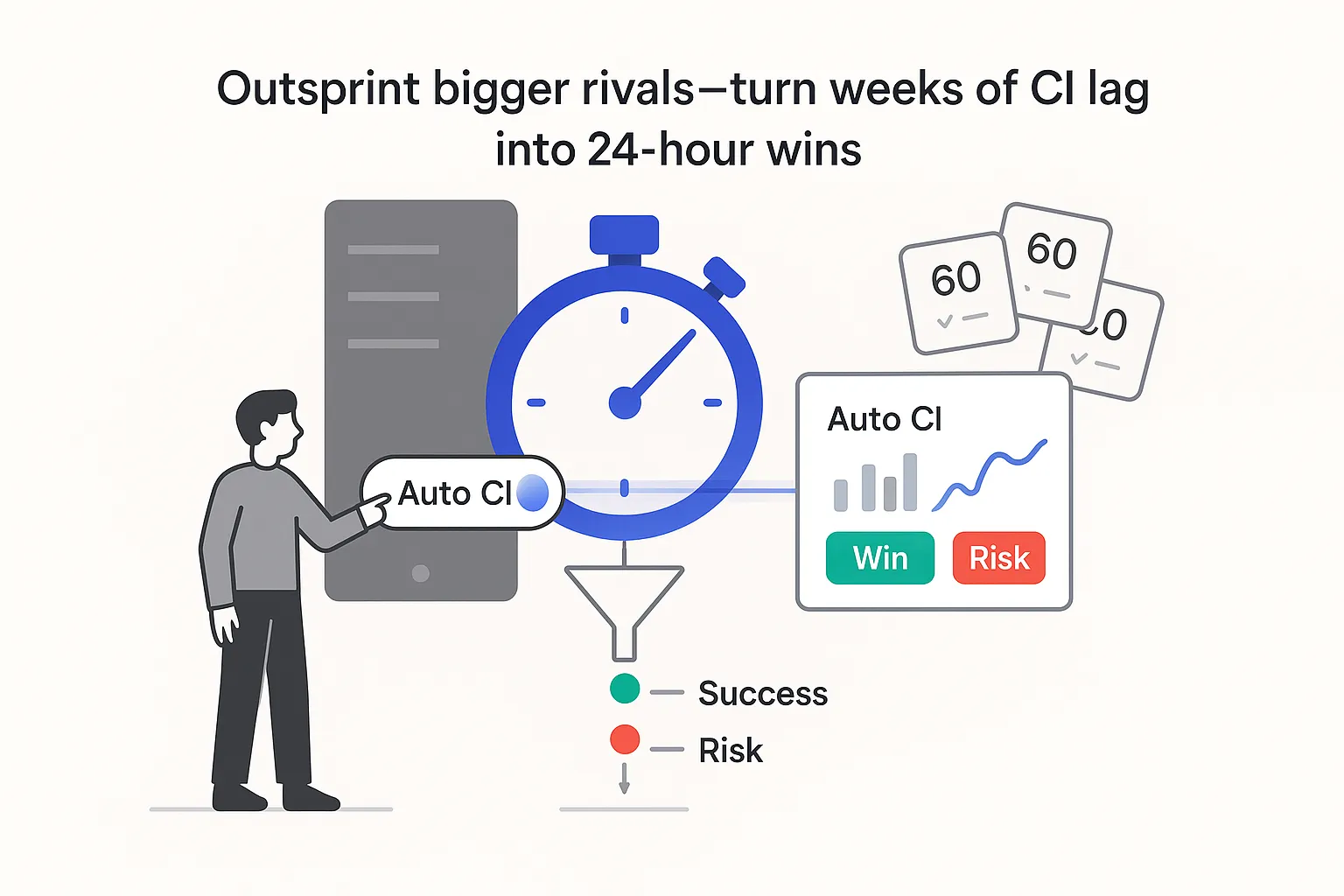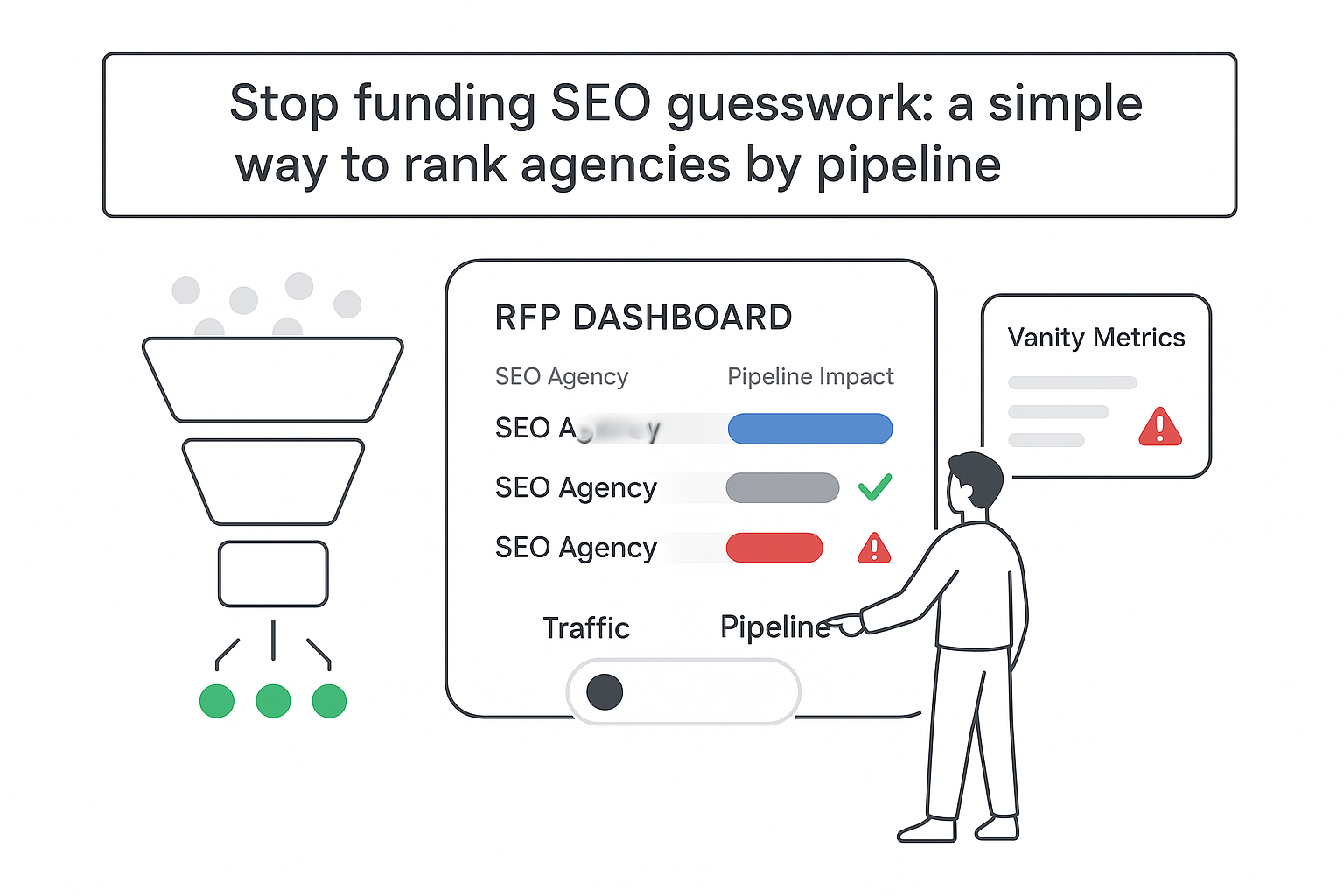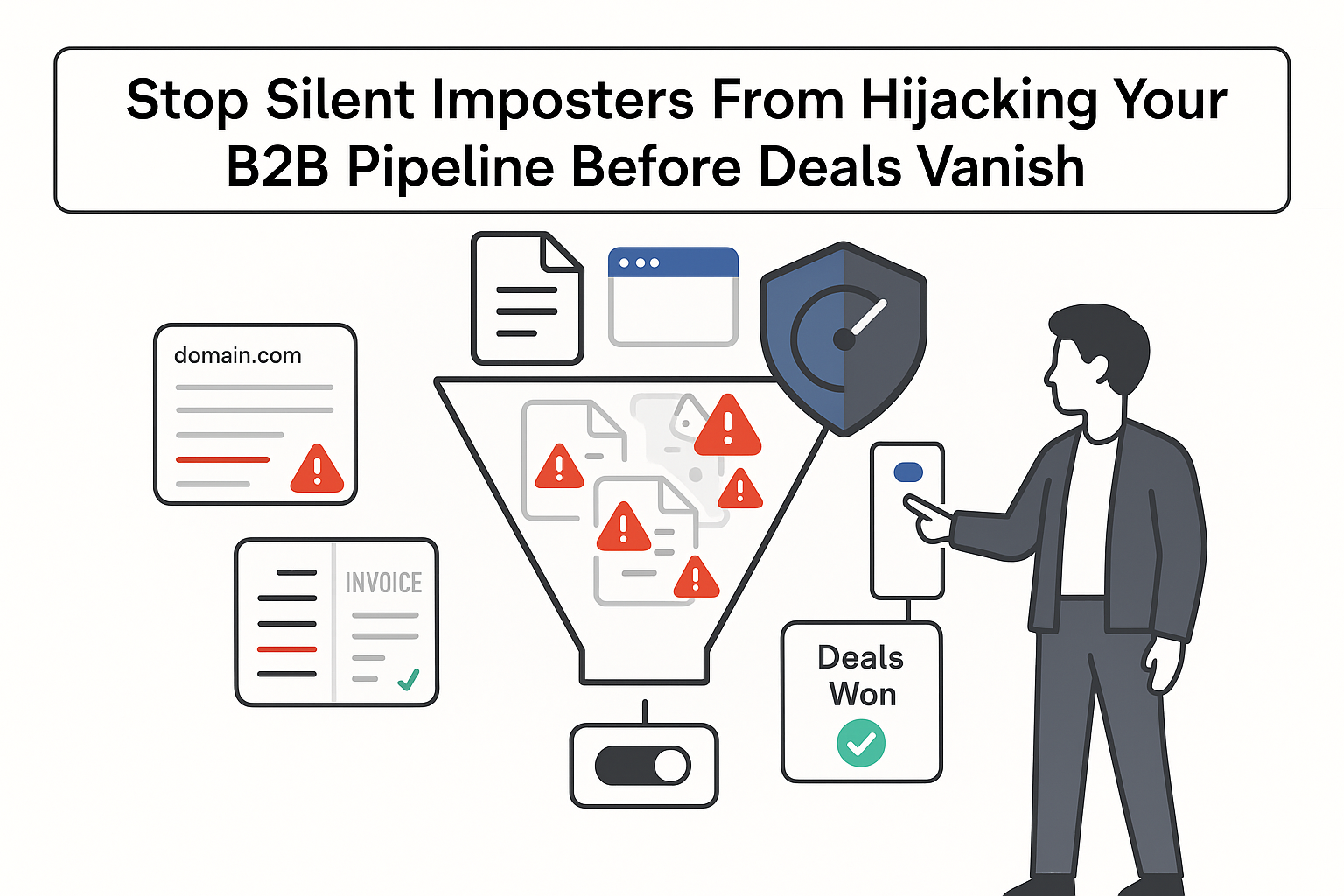Speed beats size. That’s the quiet truth behind AI competitive analysis for B2B service companies. When rivals tweak pricing, ship a feature, or shift messaging, the lag between signal and response costs real pipeline. AI shortens that lag. It turns scattered data into clear actions I can see, measure, and share with my board. No drama. No guesswork. Just faster decisions and cleaner handoffs to Sales and Marketing.
AI competitive analysis
If I care about revenue predictability, AI competitive analysis is my shortcut to speed-to-insight and accountable outcomes. It replaces manual research with smart automation that feeds my CRM, arms my reps, and updates my strategy rhythm without adding more meetings. For broader context on building research flows with agents, see market research.
What I measure (calibrate with your own telemetry):
- Time freed: teams often report 40-60 hours per month saved from manual tracking, summarized into weekly briefs; I verify with time logs.
- Tighter feedback loops: win/loss drivers tagged inside the CRM within 24-48 hours of stage change; I spot-check for accuracy and coverage.
- Pipeline impact: content and messaging tests launched within 7 days, with early indicators in 14 days; I track leading indicators first, not vanity metrics.
- Visibility: live watchlists for pricing changes, SERP shifts, and competitor launches; I maintain source links and timestamps for every alert.
30/60/90-day milestones I aim for
- 30 days: ingestion and alerting configured, first round of battlecards drafted, and a single source of truth for competitor moves aligned to CRM fields and core KPIs (ACV, win rate, cycle length).
- 60 days: trend lines for pricing, feature gaps, and SERP positions; two content pieces aimed at verified gaps; SDR/BDR email and call scripts updated and tested.
- 90 days: leading indicators of lift in SQL volume or win rate, shorter sales cycles in target segments, and a quarterly CI summary tying insights to pipeline movement and decisions taken.
A five-part framework I use
I keep this deliberately simple: goals at the top, structured data streams into analysis, visuals for decisions, and automation for monitoring.
1) Define intelligence goals
- Start with revenue levers: ACV (average contract value), win rate by segment, and cycle time for the top three offers.
Example OKRs:
- Increase mid-market win rate by 5%: identify the top three competitor claims blocking deals, ship counter-messaging, train SDRs on objection handling.
- Lift ACV by 10% without hurting conversion: map price bands by region, test two value-add bundles, validate perceived value via 20 customer conversations.
Decision cadence:
- Weekly: triage alerts and early tests.
- Monthly: synthesize patterns and adjust plays.
- Quarterly: present what moved revenue, what to stop, what to double down on.
Focus prompts I use:
- ICP: Which segment delivers the highest LTV with the shortest cycle?
- Buying committee: Who signs, who blocks, who feels the pain?
- Jobs-to-be-done: What progress does the buyer expect in week one and month one?
2) Gather competitor data with AI
Pull sources I already touch, then add structured feeds:
- SERPs and top-ranking pages - tools like SEMrush can help
- Review sites and testimonials - examples include ReviewTrackers
- Pricing and packaging pages
- Sales collateral and case studies
- Job posts, hiring velocity, and locations - apply natural language processing to extract roles and signals
- Tech tags and partner pages
- Social channels and customer forums - platforms like Brandwatch support listening and sentiment
- Patents and innovation signals - track with resources such as PatentSight or automate parsing of patent filings
Use compliant scraping, official APIs, and connectors. Store raw artifacts and enrich with metadata, timestamps, and source links. Standardize entities for cleaner comparisons with data-gathering utilities, and roll insights up with rules-based data analysis.
Data quality gates:
- Freshness: timestamps checked, alerts only for net-new changes.
- Completeness: coverage across the top five rivals and top three segments.
- Accuracy: source-of-truth links attached to each insight.
- Governance: access controls, audit logs, and clear owners.
3) Analyze data with AI
Ask for structured outputs with citations. Avoid chatty reasoning; request JSON-like objects with fields for type, impact, and confidence.
Useful patterns:
- Summarize key changes with quoted lines and URLs; include impact and confidence.
- Compare Feature A vs. Feature B across three rivals; tag gaps by segment and use case.
- Extract pricing bands, discount hints, and paywall signals; flag ambiguity.
Safeguards:
- Ask for final conclusions only, supported with citations.
- Red-team prompts that check for overreach or missing sources.
- Require a confidence score and a reason code for any strong claim.
Win/loss insight template I keep consistent:
- Deal context: segment, ACV, stage exited
- Claimed blocker: quote and source
- Counter-message: short version and talk track
- Proof: link to asset or customer result
- Next step: what to test, who owns it, due date
4) Visualize insights
Visuals turn summaries into shared actions:
- Positioning map by segment and message lane - try Strategic Group Mapping Template
- Feature parity matrix with gaps highlighted - start from a Competitor Analysis Template
- Price-versus-value quadrants with notes from real calls
I export views to slideware or push snapshots into CRM notes. Before and after comparisons show progress to my team and board. If you use Miro, explore Miro's AI-powered features and Miro's AI-powered workflows to speed up diagramming. You can also just start with Miro directly.
5) Monitor and automate
Alert rules I set:
- Pricing changes on named rivals
- Feature announcements or beta pages
- Big SERP moves for money pages
- Hiring spikes in engineering or sales
CI rituals:
- Weekly 15-minute sync to triage alerts and assign owners
- Monthly 45-minute review of trends and tests
- SLAs for content updates, battlecard refreshes, and messaging tweaks
A simple flow that works:
- Detect page change - classify type - tag product or pricing - route to channel - log in CI table - owner acknowledges - close with outcome and timestamp.
Stack choices and governance
I build a lean stack by function and keep governance in from day one.
- Collection: connectors, compliant crawlers, and email parsers
- Enrichment: entity extraction, NER, deduplication
- Analysis: embeddings, clustering, summarization, and sentiment
- Visualization: boards, charts, and shareable views
- Automation: schedulers, webhooks, and alerting
Build vs. buy:
- Build if I need heavy customization or strict data residency; expect more engineering and upkeep.
- Buy if I want speed and lower maintenance; verify privacy, data retention, access controls, and SSO.
- Hybrid for keeping my own data store with a vendor UI on top.
Must-haves for B2B services:
- CRM, chat (Slack/Teams), and marketing automation integrations
- SOC 2 and GDPR readiness with documented data handling
- Role-based permissions, audit logs, and version history
- Configurable schemas for segments, offers, and regions
Selection scorecard:
- Completeness of rival coverage - platforms like Crayon can help
- Time-to-setup
- Quality of structured outputs (not long essays)
- Governance features that keep me safe
Examples that fit parts of this stack include Brandwatch for social listening, SEMrush for SEO and content gaps, ReviewTrackers for reviews, Klenty for sales workflows, and PatentSight for innovation signals.
Agents and operating model
I think of agents as reliable specialists that hand off work cleanly:
- Researcher: watches pages, job posts, SERPs; classifies changes
- Summarizer: condenses long pages into cited briefs
- Analyst: compares pricing, features, and messaging by segment
- SDR/BDR Insights: turns intel into objection handling, emails, call openers
- Content Planner: identifies gaps and outlines pieces that rank and convert
I tie tasks to outcomes:
- Faster battlecards for the top five rivals
- Clean objection-handling scripts with proof
- ABM messaging that reflects the latest shifts
- Focused content that wins real searches
Governance keeps agents useful:
- Rate limits to control costs and avoid noise
- Audit logs for every agent action
- Approval steps for anything public-facing
Operating sketch:
- Sources feed a staging table
- Researcher classifies - Summarizer condenses - Analyst compares
- Outputs go to a visual board, then route to CRM fields and Sales channels
- Approvers sign off; the system logs outcomes
Ownership (RACI):
- Responsible: CI lead for flow health
- Accountable: Marketing or RevOps leader
- Consulted: Sales, Product, Regional leaders
- Informed: Executive team via monthly rollups
Fast deployment sequence I use:
- Connect sources and define scope (2-3 hours)
- Create taxonomies for segments, offers, regions (1 hour)
- Set prompts for summary and comparison outputs (1 hour)
- QA on five representative pages (1 hour)
- Route insights to boards and CRM (1-2 hours)
- Schedule alerts and the weekly digest (30 minutes)
By team, how value shows up
- Marketing: where rivals win clicks and attention; which pages to build next. KPIs: organic traffic, SQLs, assisted revenue. Outputs: content briefs, SERP maps, messaging updates.
- Sales: why deals slip and how to counter claims. KPIs: win rate, cycle time. Outputs: battlecards, talk tracks, objection banks.
- Product: which features matter in real deals and how competitors position them. KPI: adoption in target segments. Outputs: comparison tables and customer quote packs.
Templates that convert insight into action
Templates cut friction and standardize quality.
- Competitor analysis, one page: segments and ICP notes; value props by segment; pricing and packaging highlights; differentiators buyers actually mention; SERP footprint for priority keywords. Tip: combine AI summaries with human notes; keep citations on-page. Start with a Competitor Analysis Template.
- Porter’s Five Forces and strategic group mapping: weight each force for your niche. In services, switching costs often stem from contracts, relationships, onboarding time. Map the field with a Porter's Five Forces Template and a Strategic Group Mapping Template.
- Strategy diamond: Arenas, Vehicles, Differentiators, Staging, Economic logic translated from AI insights. Example: focus on mid-market tech in two regions; lead with faster onboarding; staff senior specialists; package retainers with clear SLAs. Use a Strategy Diamond Template.
- 3C analysis (Company, Customers, Competitors): company strengths and constraints; customer pains and outcomes; competitor claims, pricing hints, and patterns. Use it to shape positioning, sprints, and content with a 3C Analysis Template.
- Affinity diagram: feed transcripts, review quotes, sales notes; AI clusters themes like speed, price, onboarding, support; attach real quotes and counts per theme. Try an Affinity Diagram Template.
- Research plan, light but clear: hypothesis; sources; cadence; deliverables; owners. A low-lift 4-week plan for busy CEOs:
- Week 1: setup and first briefs
- Week 2: battlecards and SDR scripts
- Week 3: content gap plan and one new page
- Week 4: rollup of metrics and go or adjust decisions
High-impact use cases
Short scenarios I prioritize because they move the needle:
- Pricing moves: inputs - competitor pages and rep notes; outputs - price bands and discount signals; decision - test a value add; metric - win rate.
- Packaging tests: inputs - package pages and usage data; outputs - bundles tied to ICP; decision - two-region experiment; metric - ACV.
- Competitor play deconstruction: inputs - launch pages and press; outputs - claims and proof gaps; decision - counter-content; metric - influenced pipeline.
- Sales battlecards: inputs - call notes and alerts; outputs - short rebuttals with proof; decision - quick training; metric - stage-to-stage conversion.
- Content gap mining: inputs - SERPs and rival content; outputs - briefs that match intent; decision - publish within 7 days; metric - organic SQLs.
- ABM account planning: inputs - account tech tags and news; outputs - tailored angles and timing; decision - outreach plan; metric - reply rate and meetings.
Enablement and communication
I keep a simple hub so teams find what they need fast: documentation, community notes, templates, recorded sessions, and a change log - focused on B2B services and longer sales cycles.
Illustrative, anonymized snapshots (validate with your own data):
- IT services firm: baseline organic SQLs at ~35/month; after ~90 days, ~60/month; win rate up several points.
- Consulting group: cycle time trimmed by about a week in a target segment; pricing confidence improved with two new bundles.
- Agency network: SERP footprint expanded for three high-intent pages; inbound quality improved with fewer no-fit calls.
I add explainers for executives:
- How search intent maps to deal stages
- How CI insights flow into CRM fields and dashboards
- A plain-language glossary for AI, embeddings, and clustering
I make internal content tactical:
- Prompt patterns that generate clean, cited summaries
- Teardown analyses of real pricing pages and how to respond
- Case studies that show input - action - result
- Read-time estimates and a short TL;DR so busy readers get the point quickly
For group learning, I run periodic live teardowns of one competitive landscape, share the agenda early, and keep the replay easy to find. I focus on what moved SQLs, win rate, or cycle time - not just interesting charts. A brief latest changes note highlights new workflows, templates, or scoring guides with a short demo clip and a what leaders care about summary (time saved, clarity gained, speed to action).
Ethics, attribution, and accountability
This is not a quarterly report that sits in a folder. AI competitive intelligence is a living system that tracks changes, sorts signal from noise, and routes actions to the right owner. Accountability matters. Every insight should link to a metric, a task, and a timestamp so I can report with confidence.
Data ethics I uphold:
- Respect terms of service and legal standards
- Label sources and tag confidence levels
- Protect personal data with access controls and audit trails
- Review automated outputs with a human before anything is published
Getting started inside your company
Two low-friction paths tend to work:
- Talk through one sample report and map insights directly to pipeline levers, then pick a single segment to pilot.
- Start with a small set of templates and an agent workflow, prove value in ~30 days with instrumented metrics, then scale.
Either path works. What matters is ownership of results, clean reporting, and a cadence that moves real numbers. AI competitive analysis is not magic. It’s a practical way to cut noise, keep the team focused, and turn competitive change into revenue. When the system runs, you feel it: fewer surprises, faster cycles, clearer choices.
If you want a jump start, Use this template to spin up an AI agent that automates parts of this CI workflow.







.svg)